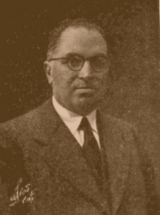U.Porto Memory
University of Porto Famous Alumni
Américo Pires de Lima
 |
Américo Pires de Lima 1886-1966 Physician, botanist, university teacher and explorer |
 Américo Pires de Lima was born in Areias, Santo Tirso, on 23 February 1886.
Américo Pires de Lima was born in Areias, Santo Tirso, on 23 February 1886.
He completed his secondary education in Porto and then the Pharmacy course, from which he transferred to Medicine at the Medical-Surgical School of Porto. At this faculty, still as a student, he taught practical classes of Bacteriology as an assistant teacher at the Nobre Laboratory (1910-1911), and completed the degree on 17 July 1911. He achieved the highest mark for his inaugural thesis presented to the Faculty of Medicine of Porto, entitled O Valor higiénico do leite do Porto (contribuição para o seu estudo) [The health value of milk in Porto [a contribution to its study].
Having completed the degree, he ran for the position of army doctor. His military career ended when he was promoted to the rank of Lieutenant-Colonel.
On 12 April 1912, he was promoted to Assistant of Clinical Medicine at the Faculty of Medicine, University of Porto, but resigned in October of that same year. The following year, he was appointed 2nd Assistant of the 3rd group (Zoology), of the 3rd Department (Historical-Natural Sciences) of the Faculty of Sciences of Porto. Shortly thereafter, he transferred to the Botany group, in which he was 1st Assistant (appointed in 1919), and Full Professor (appointed in 1921).
During World War I, he was drafted in 1916 as a medical officer and integrated in the expedition to Mozambique, where he served as Chief of the Department of Health and Bacteriology. While in this Portuguese former colony, he collected plants and animals and conducted anthropological observations.
On 16 January 1919, he initiated a fruitful collaboration with the School of Pharmacy, by being in charge of a course. At this school, he served as ordinary contracted teacher (1920) and effective ordinary teacher (1925).
 At the University of Porto, he performed other important duties. He ran the Faculty of Pharmacy (between 1929 and 1932), his Criptogamy Laboratory, and also the Faculty of Sciences (from 3 October 1935 to 28 April 1945) and the Institute of Botany "Dr. Gonçalo Sampaio" (from 9 April 1935 until his retirement). While at the Institute of Botany, the university purchased Palacete Andresen, in Campo Alegre, and mobilised funds for the conversion of the building and the construction of a new Botanical Garden.
At the University of Porto, he performed other important duties. He ran the Faculty of Pharmacy (between 1929 and 1932), his Criptogamy Laboratory, and also the Faculty of Sciences (from 3 October 1935 to 28 April 1945) and the Institute of Botany "Dr. Gonçalo Sampaio" (from 9 April 1935 until his retirement). While at the Institute of Botany, the university purchased Palacete Andresen, in Campo Alegre, and mobilised funds for the conversion of the building and the construction of a new Botanical Garden.
He was also the Chairman of the Regional Council of Porto of the Association of Doctors (1939), of the Scientific Committee of the Portuguese Medical Association (1929), of the Portuguese Society of Natural Sciences (and of the Centre of Studies of the same group as the Institute for Advanced Culture), of the General Assembly, and later of the board of Journalists and Arts Members of Porto. He was also a member of various scientific institutions (honorary member of the Portuguese Society of Pharmacy and of the Broterian Society, member of the National Group of the International Academy of the History of Sciences; member of the Académie Internationale d'Histoire des Sciences, of the Centre for Demographic Studies, of the Board of Geographical Missions and Colonial Research, of the Portuguese Society of Anthropology and Ethnology, of the International Association of Medicine, and of the Brazilian Institute of the History of Medicine, and a member of the Comité Internacional de la Lumière.

He participated in scientific meetings in Portugal and abroad, and along with his brother, Augusto Pires de Lima, he wrote many articles in the field of Botany, Anthropology, Medicine, Prophylaxis, Pharmacy, Pedagogy and History, and textbooks. He also collaborated in various periodicals.
He proposed that the Institute of Botany of the Faculty of Sciences of Porto be named after Gonçalo Sampaio, a botanist he greatly admired.
He was awarded the commendation of the Military Order of Avis and received medals for the campaigns in Mozambique and the Victory Medal.
He died in Porto on 14 August 1966.
(Universidade Digital / Gestão de Informação, 2011)
Last updated: 2024-06-12 Webpage created on: 2025-06-13 16:40:11 Complaint Portal